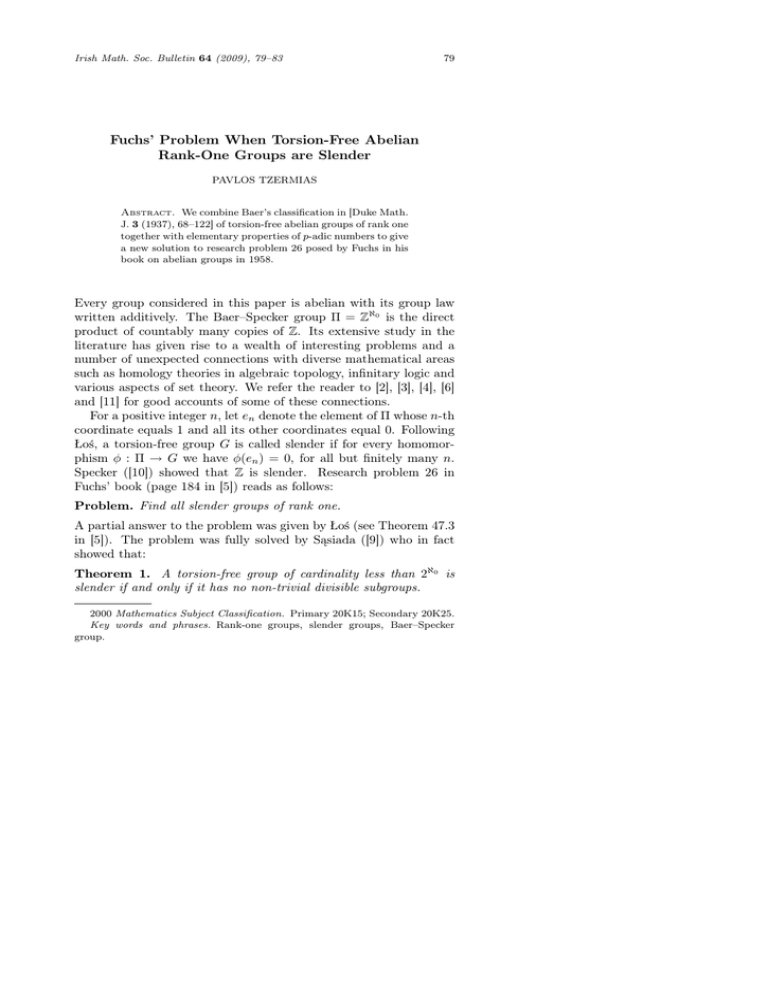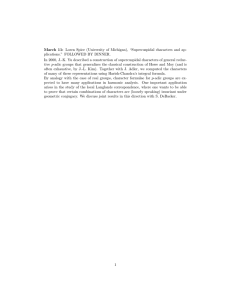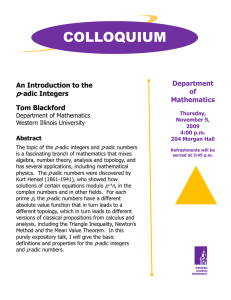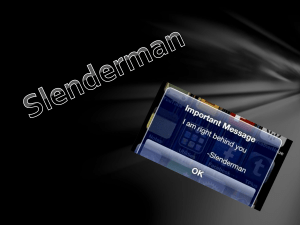Fuchs’ Problem When Torsion-Free Abelian Rank-One Groups are Slender
advertisement

Irish Math. Soc. Bulletin 64 (2009), 79–83
79
Fuchs’ Problem When Torsion-Free Abelian
Rank-One Groups are Slender
PAVLOS TZERMIAS
Abstract. We combine Baer’s classification in [Duke Math.
J. 3 (1937), 68–122] of torsion-free abelian groups of rank one
together with elementary properties of p-adic numbers to give
a new solution to research problem 26 posed by Fuchs in his
book on abelian groups in 1958.
Every group considered in this paper is abelian with its group law
written additively. The Baer–Specker group Π = Zℵ0 is the direct
product of countably many copies of Z. Its extensive study in the
literature has given rise to a wealth of interesting problems and a
number of unexpected connections with diverse mathematical areas
such as homology theories in algebraic topology, infinitary logic and
various aspects of set theory. We refer the reader to [2], [3], [4], [6]
and [11] for good accounts of some of these connections.
For a positive integer n, let en denote the element of Π whose n-th
coordinate equals 1 and all its other coordinates equal 0. Following
Łoś, a torsion-free group G is called slender if for every homomorphism φ : Π → G we have φ(en ) = 0, for all but finitely many n.
Specker ([10]) showed that Z is slender. Research problem 26 in
Fuchs’ book (page 184 in [5]) reads as follows:
Problem. Find all slender groups of rank one.
A partial answer to the problem was given by Łoś (see Theorem 47.3
in [5]). The problem was fully solved by Sąsiada ([9]) who in fact
showed that:
Theorem 1. A torsion-free group of cardinality less than 2ℵ0 is
slender if and only if it has no non-trivial divisible subgroups.
2000 Mathematics Subject Classification. Primary 20K15; Secondary 20K25.
Key words and phrases. Rank-one groups, slender groups, Baer–Specker
group.
80
Pavlos Tzermias
Sąsiada’s result is superseded by Nunke’s characterization of all
torsion-free groups which are slender (see [7] and [8]).
Theorem 2. A torsion-free group is slender if and only if none of
its subgroups is isomorphic to Π, Q or the p-adic integers Zp for
some prime p.
The purpose of this short note is to give a new solution to the original
problem of Fuchs. We claim no novelty for the general p-adic flavor
of our arguments which is not uncommon in inquiries of this type
but, as far as we can tell, a solution like ours has not appeared in
the literature before. Let us first briefly recall Baer’s classification
([1]) of torsion-free groups of rank one (see [5] for details).
Consider a torsion-free group G and a non-zero element g ∈ G.
For a prime number p, define the height Hp (g) of g at p to be the
maximum integer k ∈ N such that the equation pk x = g is solvable
in G (if no maximum k exists, we set Hp (g) = ∞). The height H(g)
of g is the infinite tuple
H(g) = (Hp1 (g), Hp2 (g), . . . , Hpn (g), . . .),
where p1 , p2 , . . ., pn , . . . is the increasing sequence of prime numbers.
Consider the set H of infinite tuples (k1 , k2 , . . . , kn , . . .), where
kn ∈ N ∪ {∞} for all n. Define a partial order ≤ on H as follows:
(k1 , k2 , . . . , kn , . . .) ≤ (m1 , m2 , . . . , mn , . . .)
if kn ≤ mn for all n (where it is understood that s ≤ ∞ for all
s ∈ N ∪ {∞}).
We also define an equivalence relation ∼ on H as follows:
(k1 , k2 , . . . , kn , . . .) ∼ (m1 , m2 , . . . , mn , . . .)
provided that kn = mn for all but finitely many n and that kn 6= mn
can happen only if neither kn nor mn equals ∞. An equivalence
class of H under ∼ is called a type and the set of all types is denoted
by T . It is easy to see that the partial order ≤ on H defined above
induces a partial order (also denoted by ≤) on the set of types T .
Now suppose that G is of rank one and let g, g 0 be any two nonzero elements of G. It is not difficult to show that H(g) ∼ H(g 0 ).
Therefore, all non-zero elements of G are of the same type, which
we call the type of G and denote by T (G). Every torsion-free group
of rank one is isomorphic to a subgroup of Q and Baer showed in
[1] that the set of isomorphism classes of torsion-free groups of rank
one is parametrized by T via the bijective correspondence given by
Fuchs’ Problem
81
G 7→ T (G). In addition, a torsion-free group G1 of rank one is
isomorphic to a subgroup of a torsion-free group G2 of rank one if
and only if T (G1 ) ≤ T (G2 ).
We now give a new solution to the original problem of Fuchs:
Theorem 3. A torsion-free group of rank one is slender if and only
if it is not isomorphic to Q.
Proof. One direction is standard: Let Σ denote the direct sum of
countably many copies of Z. Since Q is an injective Z-module, the
homomorphism Σ → Q defined by
(x1 , x2 , . . . , xn , . . .) 7→
∞
X
xn
n=1
can be lifted to a homomorphism φ : Π → Q such that φ(en ) 6= 0,
for all n. Therefore, Q is not slender.
To prove the converse, let G be a torsion-free group of rank one
which is not isomorphic to Q. From the discussion of types given
before, it follows that T (G) can be represented by an infinite tuple
(k1 , k2 , . . . , kn , . . .), where kn 6= ∞ for at least one n ∈ N. It is easy
to see that this tuple is equivalent to (k1 , k2 , . . . , kn−1 , 0, kn+1 , . . .)
and that
(k1 , k2 , . . . , kn−1 , 0, kn+1 , . . .) ≤ (∞, ∞, . . . , ∞, 0, ∞, . . .).
As the latter tuple represents the type of the group Z(p) of rational
numbers with denominators not divisible by the prime p = pn , we
may assume that G is a subgroup of Z(p) . Since subgroups of slender
groups are obviously slender, it suffices to show that Z(p) is slender.
Let i : Z(p) → Zp denote the natural embedding of Z(p) in the ring
of p-adic integers. We will use the well-known fact that for y ∈ Z(p)
the p-adic expansion of i(y) is ultimately periodic, i.e. when we write
i(y) =
∞
X
aj pj
j=0
then there exist positive integers N and r such that aj+r = aj for
all j ≥ N . Now let φ : Π → Z(p) be a homomorphism such that
φ(en ) 6= 0 for infinitely many n. Without loss of generality, we may
assume that φ(en ) 6= 0 for all n. We can therefore find, for each n, an
integer bn such that φ(bn en ) is a positive integer. Let yn = φ(bn en ).
Then i(yn ) has a finite non-zero p-adic expansion for all n. Now
82
Pavlos Tzermias
consider x = (pc1 b1 , pc2 b2 , . . .) ∈ Π, where the sequence of natural
numbers c1 , c2 , . . . has been chosen to satisfy
pcn+1 > pn (pcn yn + pcn−1 yn−1 + . . . + pc1 y1 )
for all n. Let y = φ(x). Note that for all n we get
y = pc1 y1 +pc2 y2 +. . .+pcn yn +φ(0, 0, . . . , 0, pcn+1 bn+1 , pcn+2 bn+2 , . . .).
We clearly have cn+1 ≤ cn+2 ≤ . . ., so
(0, 0, . . . , pcn+1 bn+1 , pcn+2 bn+2 , . . .)
is divisible by pcn+1 in Π. Hence,
y ≡ pc1 y1 + pc2 y2 + . . . + pcn yn
(mod pcn+1 ).
for all n. By our assumption on c1 , c2 , . . ., we see that the p-adic
expansion of i(y) is obtained by writing down the non-zero p-adic expansion of pc1 i(y1 ), followed by at least 1 zero digit, followed by the
non-zero p-adic expansion of pc2 i(y2 ), followed by at least 2 zero digits, etc. Hence, the p-adic expansion of i(y) contains arbitrarily large
blocks of zero digits followed by non-zero blocks of digits and this
contradicts the fact that the p-adic expansion of i(y) is ultimately
periodic.
Acknowledgement. I thank Yasuyuki Kachi for asking me a question which, unbeknownst to me at the time, was equivalent to the
slenderness of Z and provided the motivation for this work.
References
[1] R. Baer, Abelian groups without elements of finite order, Duke Math. J. 3
(1937), 68–122.
[2] A. Blass and J. Irwin, Free subgroups of the Baer–Specker group, Comm.
in Algebra 29 (2001), no. 12, 5769–5794.
[3] E. Coleman, The Baer–Specker group, Ir. Math. Soc. Bull. 40 (1998), 9–23.
[4] P. Eklof and A. Mekler, Almost free modules. Set-theoretic methods, Revised
Edition, North Holland Publishing Co., Amsterdam, 2002.
[5] L. Fuchs, Abelian groups, Publishing House of the Hungarian Academy of
Sciences, Budapest, 1958.
[6] W. Massey, How to give an exposition of the Čech–Alexander–Spanier type
homology theory, Amer. Math. Monthly 85 (1978), no. 2, 75–83.
[7] R. Nunke, Slender groups, Bull. Amer. Math. Soc. 67 (1961), 274–275.
[8] R. Nunke, Slender groups, Acta Sci. Math. (Szeged) 23 (1962), 67–73.
[9] E. Sąsiada, Proof that every countable and reduced torsion-free Abelian
group is slender, Bull. de l’Acad. Polonaise des Sciences, Série des Sciences
Mathématiques, Astronomiques et Physiques 7 (1959), 143–144.
Fuchs’ Problem
83
[10] E. Specker, Additive Gruppen von Folgen ganzer Zahlen, Portugaliae Mathematica 9 (1950), 131–140.
[11] E. Zeeman, On direct sums of free cycles, J. London Math. Soc. 30 (1955),
195–212.
Pavlos Tzermias,
Department of Mathematics,
University of Tennessee,
104 Aconda Court,
1534 Cumberland Avenue,
Knoxville, TN 37996-0612, USA
tzermias@math.utk.edu
Received on 15 December 2008.





